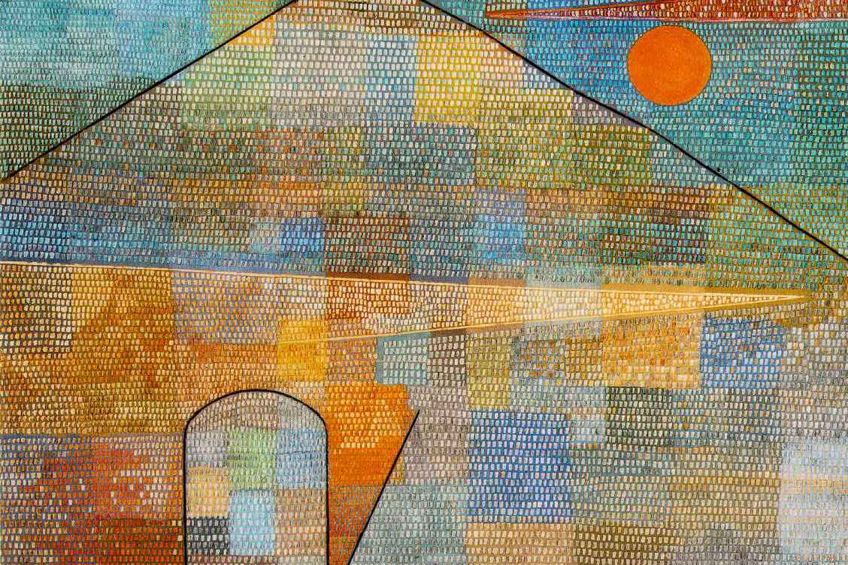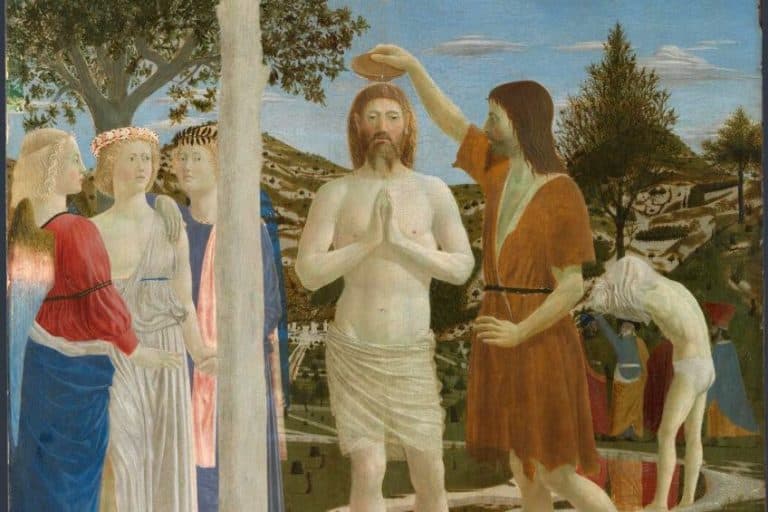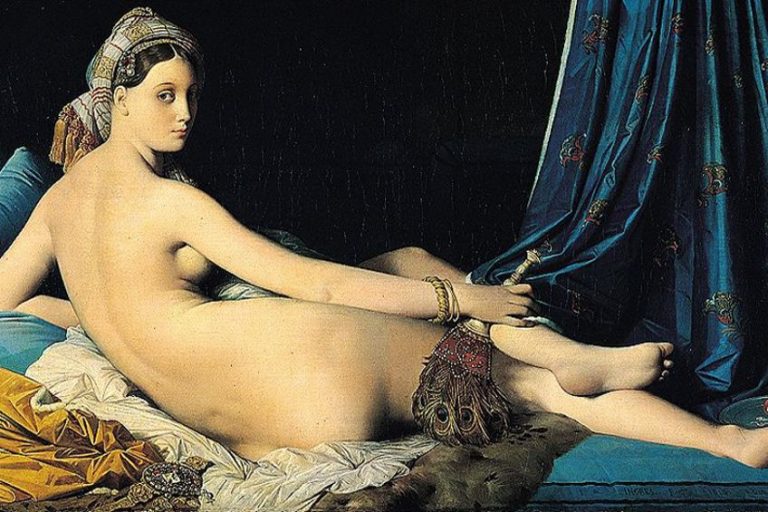Cubism Art Movement – Overview, Definition, History and Evolution
Although you may not be familiar with the intricacies of the Cubism art movement, you are bound to be aware of its key players like Pablo Picasso, Georges Braque, and Robert Delaunay. The beginning of the 20th century saw an explosion in artistic exploration, with Cubism playing an influential role in this process. In this article, we will attempt to present a Cubism definition, explore the roots of the Cubist movement, trace its developments over the first half of the 20th century, and get to know some of the most influential Cubist artists and their work.
Table of Contents
- 1 What Is Cubism?
- 2 The History of the Cubism Art Movement
- 3 Six Famous Cubist Artists and Their Work
- 4 Recommendations for Books on the Cubism Art Movement
- 5 Frequently Asked Questions
What Is Cubism?
Cubism is an art movement that emerged out of a collaboration between Pablo Picasso and Georges Braque in France at the turn of the 20th century. Building on the geometric abstraction of the Fauvism movement , Cubism broke many of the rules of traditional western art styles. Fauvism had already laid the groundwork by experimenting with bright and unexpected colors, a great example being the paintings of Franz Marc.
The Cubism art movement remains incredibly influential today, boasting more books on its subject than any other art movement. Cubism was and is a revolutionary movement, and you will find that its influences reach as far as architecture and sculpture.
The Features of Cubist Paintings
The two most distinct features of Cubist paintings are the use of an abstract, “four-dimensional” perspective and the fragmentation of scenes and people into geometric shapes.
When you look at a photograph or a scene in real life, you are viewing the scene from a single perspective. All of the objects within the frame fit together relative to this single perspective. The traditional western style of painting has long attempted to mirror this single perspective perfectly, giving the viewer the impression that they are looking directly at the scene behind the work of art. Traditional artists use shading and highlights to mirror the depth of the three-dimensional scene on the two-dimensional canvas.

The most distinct feature of Cubism is that it completely disregards this single three-dimensional perspective. The objects within the scene are fragmented into a multitude of different geometric components, each representing the objects from a slightly different perspective (from the left, the right, the top, or the bottom). The artists then arrange each fragment on the canvas to present the subject of the painting from many different perspectives at the same time.
If you take Picasso’s Weeping Woman, for example, you can see that you are looking at a woman’s face and that she is crying, but you cannot quite determine the direction from which you are looking at her. Are you looking at her head-on or from one side?
Cubist paintings represent a multitude of different perspectives within one picture. Rather than representing three-dimensional space on a two-dimensional canvas, cubist artists represent what is called the “fourth dimension.”
Another distinct feature of the cubist art movement is the hard-edged geometric shapes that make up the compositions. Deriving its name from the Latin word for a cube, Cubism breaks images and objects down into fragments of squares, cones, spheres, pyramids, and other geometric shapes. There are three distinct periods within the Cubism art movement: Analytical Cubism, Synthetic Cubism, and Orphic Cubism.
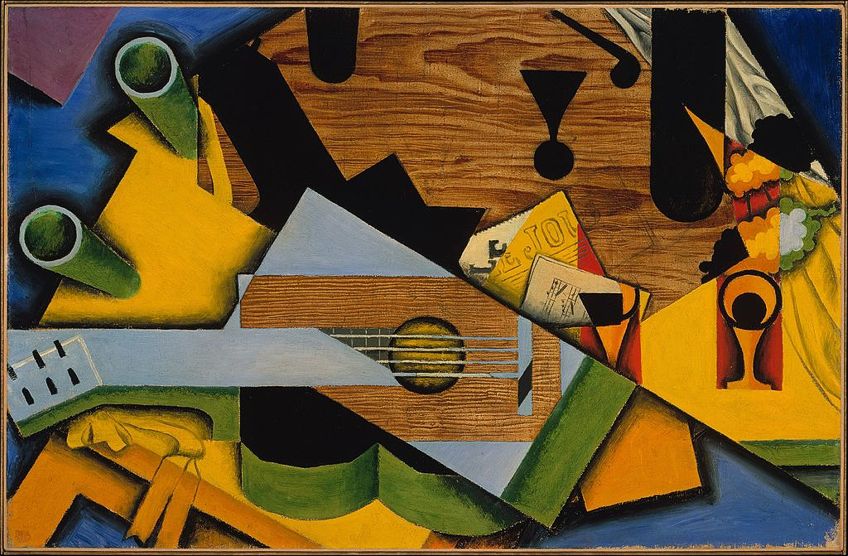
The History of the Cubism Art Movement
Pablo Picasso is often regarded as the father of the Cubism movement, beginning with his painting, Les Demoiselles d’Avignon, which he finished in 1907. This piece depicts the fragmented bodies of five prostitutes. A lot of the influence for this piece came from African tribal art, which Picasso had seen at the Palais du Trocadero, an ethnographic museum in Paris. This period of Picasso’s artistic career was known as his “African phase” and the work he did here was integral to the Cubist movement. This piece also took influence from the work of Paul Cézanne, whom Picasso had studied intently.
Georges Braque met Picasso in 1907, and initially, he did not like Les Demoiselle d’Avignon. However, over the next year, Braque and Picasso realized that their works from the past few years were becoming increasingly similar. The two artists began a close collaboration that lasted until 1915, in which they worked together to establish Cubism as a distinct art movement.
It was in 1908 that Louis Vauxcelles, an art critic, first used the word “cubist” to describe one of Braque’s paintings. Although used rather mockingly, the name stuck, and the Cubism art movement was born.

Another influential artist by the name of Andre Derain took an interest in the collaboration between Picasso and Braque. While much like Braque’s initial reaction to Picasso’s Demoiselle d’Avignon, people did not respond positively to this new genre at first, it was soon that several artists including Robert Delaunay, Fernand Leger, and Marcel Duchamp, began to call themselves “Cubists.”
Each artist influenced the Cubism art movement with their unique style, with some members moving so far towards total abstraction that even Picasso and Braque did not approve.
Juan Gris, a studio neighbor of Picasso, began to take an active interest in Cubism in 1911. Alongside Braque and Picasso, Gris was influential in the sub-genre of synthetic Cubism. Gris, however, attempted to take a more theoretical approach to Cubism than either Picasso or Braque.
The Cubism art movement did not last long, however, gradually dissolving at the start of the First World War in 1914. Many of the key artists, including Braque and Derain, were recruited for military service, and in 1915, Braque was the victim of a brain injury. Although he survived, the injury caused the breakdown of his and Picasso’s collaboration and friendship.
Although Picasso and Braque are typically the most well-known proponents of the Cubism art movement, it continued to be developed by several other artists. Artists like Juan Gris, Marcel Duchamp, Jean Metzinger, Roger de la Fresnaye, Fernand Leger, as well as Sonia and Robert Delaunay continued to experiment with Cubist ideas.

The Analytical Cubism Period
The analytical Cubism period represented the early phases of the Cubism art movement between 1908 and 1912. The term originates from the organized dissection of the subject of study by viewpoint. The resulting pieces consist of fragmented imagery, with overlapping planes and multiple viewpoints. The focus moved away from cubes, and Braque, Picasso, and Gris began to focus more on small surfaces and planes that were slightly overlapped and delineated by black, white, or colored lines.
Often the image was much denser at the center of the canvas, and the fragments were more scattered towards the edges. The color pallet was much more basic and muted during these early years so as to ensure the viewer was still able to see the image on the canvas. The bright and bold colors that many people associate with the Cubism art movement only began to develop later. An example of an analytical cubist artwork is Glass on a Table, which was completed by Braque in 1910.
During the analytical Cubism period, Picasso experimented with material collages using wood, sand, and other textiles. While some sources view these works as part of the synthetic Cubism period, others see them as the first steps towards the mixed media that characterized this later period.
The Synthetic Cubism Period
Although this period of the Cubism art movement lasted for only two years, from around 1912 to 1914, it is distinct from the analytic period before it in several ways.
The works produced within the synthetic Cubist phase had little pictorial depth, moving away from fragmenting and reassembling a single object. In contrast, artists began to use fragments of different and unrelated subjects to create new and very abstract images.
Another stark difference to analytic Cubism was the use of bright and bold colors. Juan Gris’ A Pot of Geraniums, which was painted in 1915, demonstrates this shift in the pallet. Finally, the use of mixed-media collages increased dramatically. Using anything from playing cards, cigarette boxes, and sheet music to newsprints, the artists added yet another dimension to the Cubist style.
The Orphic Cubism Period
The term “Orphic Cubism” was coined by Guillaume Apollinaire, a French poet, in 1912. This offshoot from the Cubism art movement, spearheaded by Robert Delaunay, was by far the most abstract. Orphism took significant influence from Fauvism in its use of bright, bold, and varied colors.
The forms in Orphic Cubist paintings were mostly circular, and the compositions combined warm and cold, complementary, and contrasting colors. You can also see a greater focus on the light within these paintings. Many of the Orphic designs were purely abstract and did not consist of any concrete subjects. You can see the distinct style of Orphic Cubism in the works of Sonia and Robert Delaunay.

Six Famous Cubist Artists and Their Work
Due to the relatively short life of the Cubism art movement, there are a relatively small number of influential artists. You may know many of their works but little about the artist behind the brush. Here, we present the six most famous artists within the Cubism art movement and will explore some of their paintings.
Pablo Picasso, 1881-1973
Of course, we have to start with Picasso because when you think of Cubism, Picasso is the first thing that comes to mind. Pablo Picasso was born in Malaga, Spain at the end of 1881. His country’s history and culture were a significant influence on Picasso throughout his life and artistic career.
Picasso started his artistic career at a young age, with his first exhibition at around 20 years of age, following exposure to the art trends of the day at the Cafe Els Quatre Gats. Before this exhibition, he attended the Academy of Fine arts in La Lonja.
Early in Picasso’s career, he was predominantly a post-impressionist artist, and remnants of his impressionist style carried over into his later works. Before Picasso entered his Cubist period in 1908, his style varied from his Blue Period to his Rose Period.
While the Cubism art movement is known to have faded out at the start of the First World War, Picasso continued to refine his Cubist style. Guernica, a piece that protested the bombs dropped on villagers in Spain, was completed in 1937 and is commonly thought to represent the pinnacle of Picasso’s Cubist style.
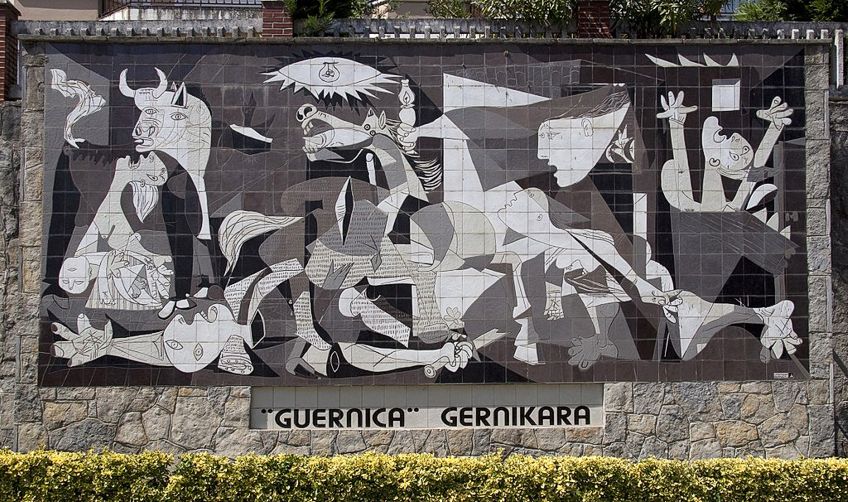
Portrait of Ambroise Vollard (1909)
A perfect example of analytic Cubism, this was one of the first Cubist paintings completed by Picasso in 1909. The painting portrays a fragmented and melancholic man in shades of gray and brown, with a touch of yellow in the face.
The man’s face is most visible in the center, an example of the clustering that is typical of analytic Cubism. Many people failed to recognize Ambroise Vollard as the subject of the painting. A young boy who was the son of Vollard’s friend is said to have recognized the man immediately, however, indicating that despite the abstract form of the painting, Picasso managed to artfully portray the likeness of Vollard.
Portrait of Fernande Oliver (1909)
Another piece of analytic Cubist portraiture, Picasso also finished this work in 1909. The picture combines the mountain forms influenced by the time he spent there with his mistress with the face of Fernande Oliver. The color pallet of greys and browns is, again, typical of the analytical Cubist style.
Guitars (1912-1914)
Guitars were a fixation for Picasso between 1912 and 1914. Many art historians believe that this series, which included both paintings and sculptures, represents a transition between analytic and synthetic Cubist styles for Picasso.
Still Life with Chair Caning (1912)
The first of many collages for Picasso, this oval canvas includes a piece of oilcloth with the weave of a cane chair. When you first look at this piece, it is difficult to determine whether this pattern is painted or indeed glued on. Picasso artfully painted over the edges of the printed cloth with his style of Cubism paint, bringing together traditional painting and modern multi-media techniques.
Georges Braque, 1882-1963
Braque was born in France a year after Picasso in 1882. For much of his youth, Braque took influence from the traditional French styles. His time at the Ecole des Beaux-Arts in his late teens reinforced his early impressionist style.
After moving to Paris, Braque was influenced dramatically by Fauvian artists, and his shift in style was evident in his 1906 exhibition. During his first solo show in 1908, he first crossed paths with Picasso and so began their close collaboration, which lasted until 1914 when he was drafted for the war effort and received a head injury.
After the war, Braque worked alone to develop his style, which was much less structured. During his later years, Braque worked in Paris painting for ballet displays, making lithographs and jewelry while his health remained strong.

Violin and Jug (1910)
Completed in 1910, this example of analytical Cubism presents a fragmented composition of a violin and a jug. The multitude of different perspectives is emphasized by the light that hits each fragment from a different angle. As with the original works of Picasso, the color pallet consisted entirely of shades of ochre and brown.
Fruit Dish and Glass (1912)
Not a painting but a charcoal drawing, Braque finished this piece in 1912. Braque overlaid the original charcoal drawing with strips of wood-grain wallpaper and letters, making this a perfect example of the move towards synthetic Cubism.
Juan Gris, 1887-1927
Born Jose Gonzales-Perez in 1887, Juan Gris was a little younger than his peers within the Cubism art movement. Originally, Gris planned a career doing mechanical drawings for growing industries and spent three years studying at the Escuela de Artes y Manufacturas in Madrid.
After a brief time spent with the artist Jose Maria Carbonero, Gris started to consider more artistic forms of painting in 1905. Gris moved to Paris a year later, and it was here that he met the likes of Picasso and Braque and started to dabble in Cubism.
In the lead-up to World War One, Gris spent much of his time with Picasso, Braque, Leger, and Raynal. By 1912, Gris had clearly developed his own Cubist style, and Leonce Rosenberg and D.H. Kahnweiler both sponsored his paintings. Unfortunately, Gris’ artistic flair was short-lived as he died from bad health in the middle of 1927.
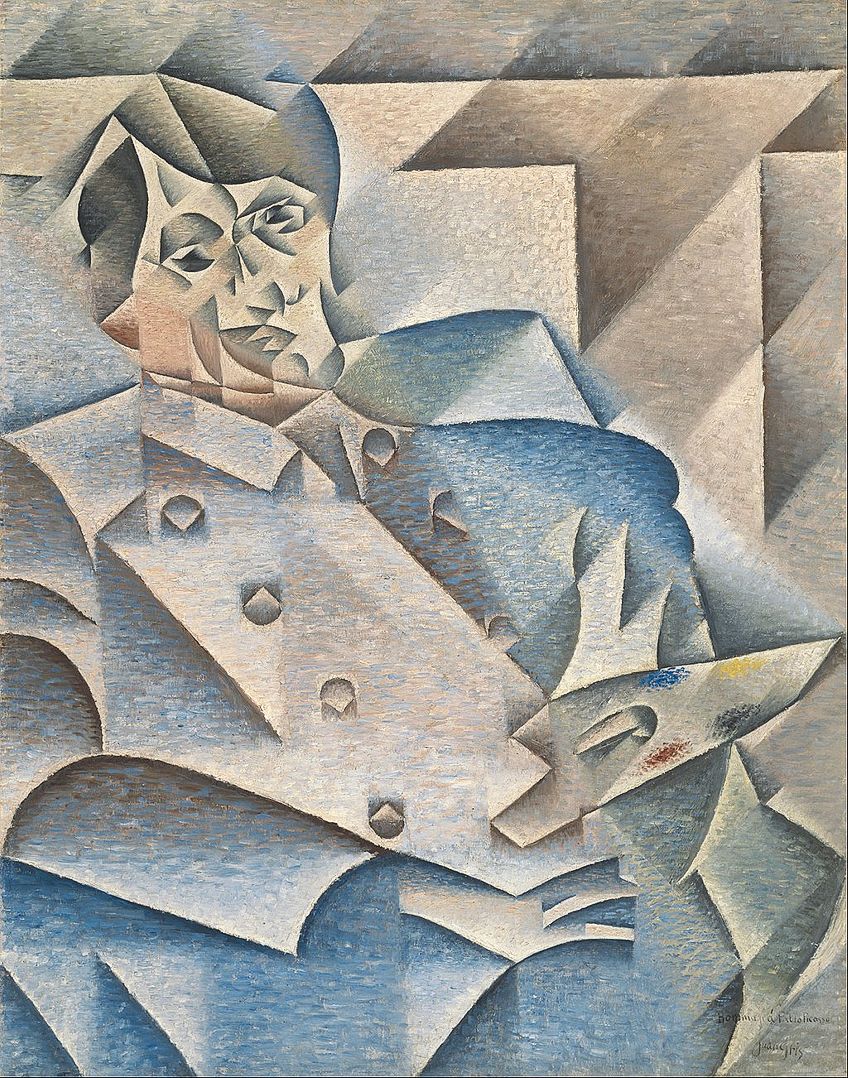
Portrait of Pablo Picasso (1912)
Painted in 1912, Juan Gris’ portrait of Pablo Picasso is a clear example of the analytic Cubist style. A muted color pallet of blues, greys, and pinks brings to life an image of Picasso holding a pallet constructed of different geometric shapes. The portrait of Picasso was one of Gris’ last analytical Cubist works, as from 1913 he began to focus on the synthetic style. Well-known pieces from this period of his career include Harlequin with Guitar, Fantomas, and The Blind.
Paul Klee, 1879-1940
Born in 1879, Paul Klee was a Swiss-German artist with a distinct artistic style. Taking influence from Cubism, Expressionism, and Surrealism, Klee went on to explore color theory extensively.
Klee was born to a family of Swiss musicians, and music heavily influenced his style throughout his life. Klee entered an exhibition in 1911 which brought him into contact with Picasso, Braque, and Delaunay. Before a 1914 trip to Tunisia, however, Klee had not experimented much with color.
Like the other artists in the Cubism movement, WWI put a stop to much of Klee’s work. By 1920 however, Klee began to work as a teacher at the Bauhaus, a school of art, architecture, and design. Klee’s work was influential until he fled Germany in 1933 as a result of the Nazis. Klee spent the last seven years of his life in Switzerland.
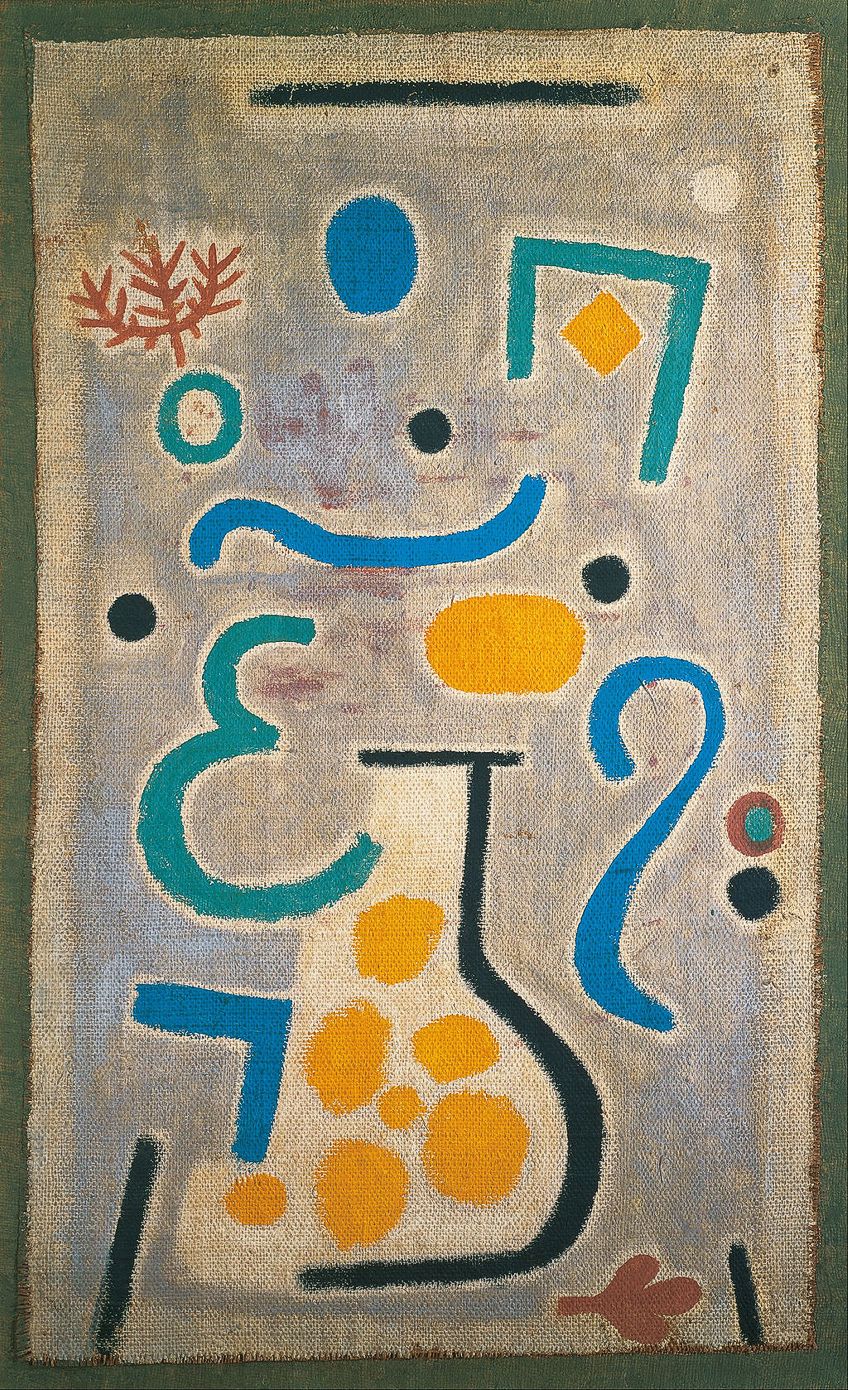
Die Vase (1938)
It was towards the end of his life that Klee’s artwork became thoroughly Cubist. Die Vase, completed in 1938 two years before his death, depicts the classic features of Orphic Cubism. Bright colors of blue and yellow contrast with brown and black. The forms are rounded, circular, and abstract.
Albert Gleizes, 1881-1953
Originally destined for material fabrication as a result of his childhood in a fabric design studio, French artist Albert Gleizes proclaimed himself to be the founder of the Cubism art movement. After spending some time in the military until 1905, Gleizes discovered painting and was soon exhibiting his art. By 1906, he was working in Paris in a commune with other artists until 1908.
By 1912, Gleizes was an influential co-author of Du Cubism, but the plans were sadly interrupted by the beginning of the war. After the war, Gleizes’ style became increasingly abstract, and he created a second artist’s commune in 1927. Gleizes remained an influential figure in the Cubism art movement, continuing to exhibit throughout the 1930s until he died in 1953.
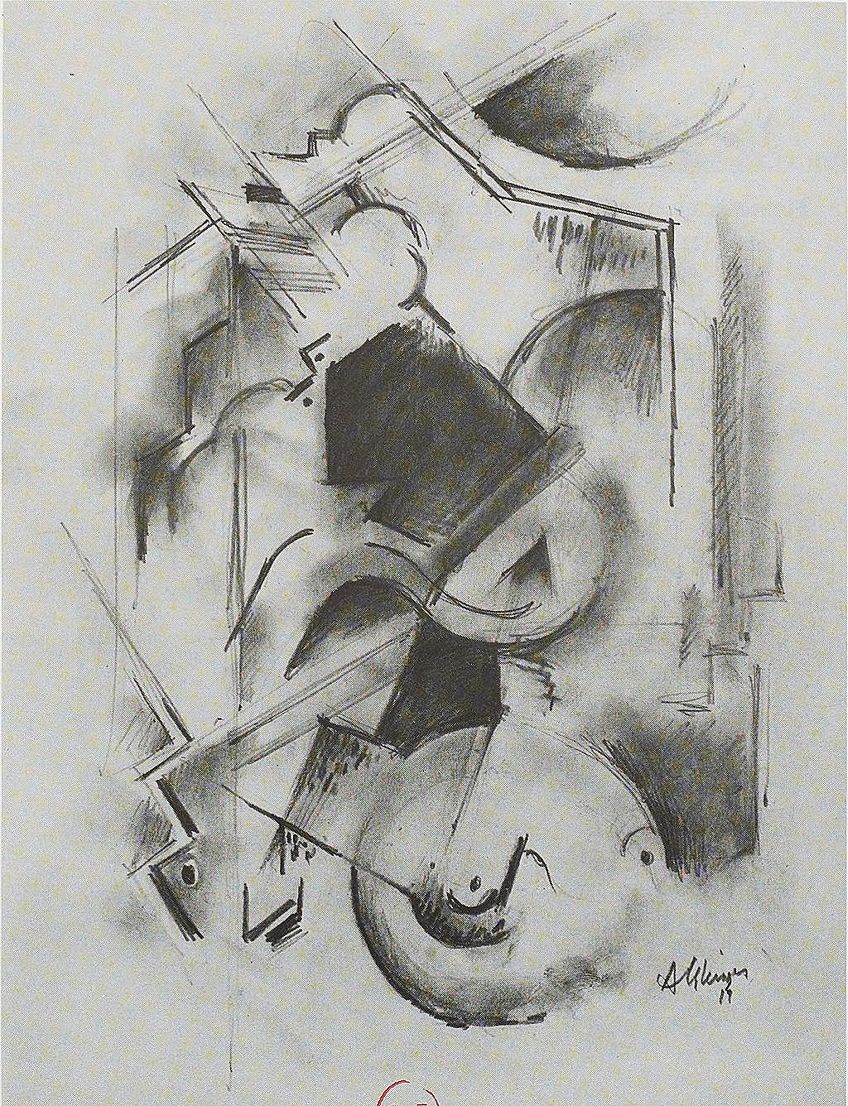
La Femme aux Phlox (1910)
Completed in 1910, this work by Gleizes is a prime example of early analytical Cubism. The scene shows a woman with flowers, fragmented into geometric shapes. The color pallet of muted greys, browns, and whites confirms its place as a piece of analytical Cubism.
Paul Cézanne, 1839-1906
Although he passed away at the dawn of the Cubism art movement, Paul Cézanne is a renowned artist and is credited with being the founder of modernism. Producing his first paintings in 1861, Cézanne began as a post-impressionist artist, later exploring abstraction through the use of different brush strokes, shadows, and highlights. Cézanne is also known for experimenting with form and color to create abstract and visually striking scenes.
Cézanne is possibly most well-known for the influence of his work on the Cubist artists who flourished after his death. Unfortunately, he was never able to see his real success as he died in 1906, which was before the Cubism art movement had taken off.
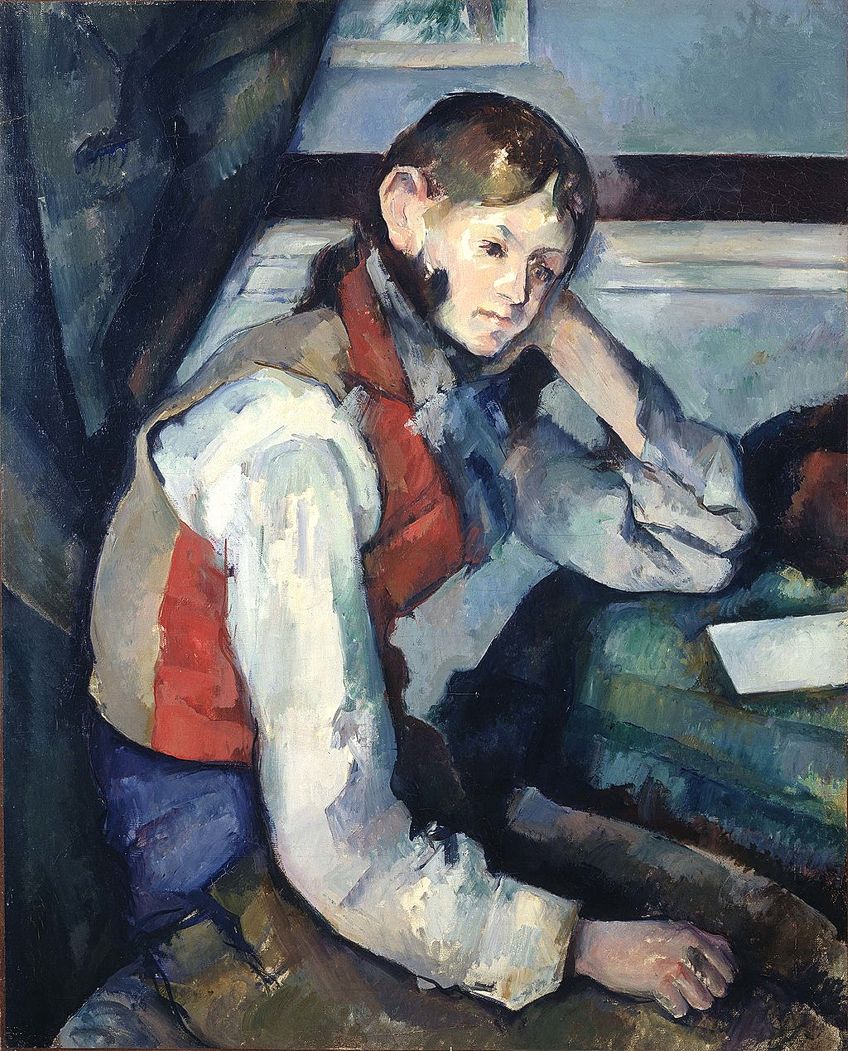
Boy in a Red Vest (1888-1890)
This painting, although completed almost 20 years before Picasso and Braque formalized Cubism as a movement, is an influence for these later works. The boy figure in the painting is seated with his head resting in his hand. Although you cannot see the geometric fragmentation that is characteristic of the Cubist style, the brush strokes that Cézanne used break up the flow of areas that should be soft and smooth, adding an interesting dimension to the painting.
Recommendations for Books on the Cubism Art Movement
If you are interested in learning more about the Cubism movement and the artists who were involved in it, then we recommend the following books.

Cubism (Movements in Modern Art)
This book by David Cottington provides some historical context to the development of the Cubism art movement in the period before the First World War. Through an in-depth analysis of Cubist paintings by Braque, Picasso, Delaunay, and many other artists, Cottington traces the role of Cubism in the development of modern art.
A Cubism Reader: Documents and Criticism, 1906-1914
Written by Mark Antliff and Patricia Leighten, this book offers an anthology of documents ranging from poetry to political manifestos, reviews, exhibition prefaces, and theoretical explorations of the cultural milieu from which the Cubist movement emerged. This is a wonderful book for those interested in the philosophical and cultural basis of the Cubism art movement as well as Cubist paintings.
Frequently Asked Questions
What Is Cubism?
It can be difficult to provide a Cubism definition because the movement was so varied, and each artist had their unique style. Beginning at the start of the 20th century, the Cubism art movement is one of the most influential of the modern era. Cubism was a radical break from traditional western painting styles in the way it attempts to portray multiple dimensions of space on a two-dimensional canvas. Cubist paintings are characterized by geometric shapes, overlapping planes, bright colors, and later, multi-media collages.
How Are Cubist Paintings Created?
There is a fair amount of variation in the mediums used to create Cubist paintings. Depending on the era, artists used the following mediums to create their Cubism paint: Textiles, newspaper, wallpaper, cigarette boxes, and other mixed-media materials.
Who Are the Cubism Artists?
The most famous Cubism painter is undoubtedly Pablo Picasso, but he worked alongside many other Cubists including Georges Braque and Juan Gris. Paul Cézanne was a predecessor to the Cubism art movement. Sonia and Robert Delaunay were particularly influential in the Orphic Cubism offshoot.
Is Picasso a Cubist?
Yes, Picasso is arguably the most well-known artist in the Cubist movement. When you think of Picasso, Cubism is the first thing that comes to mind. It was the abstract and geometric works of Picasso that set the stage for the Cubist paintings of Gris and many others.
Isabella studied at the University of Cape Town in South Africa and graduated with a Bachelor of Arts majoring in English Literature & Language and Psychology. Throughout her undergraduate years, she took Art History as an additional subject and absolutely loved it. Building on from her art history knowledge that began in high school, art has always been a particular area of fascination for her. From learning about artworks previously unknown to her, or sharpening her existing understanding of specific works, the ability to continue learning within this interesting sphere excites her greatly.
Her focal points of interest in art history encompass profiling specific artists and art movements, as it is these areas where she is able to really dig deep into the rich narrative of the art world. Additionally, she particularly enjoys exploring the different artistic styles of the 20th century, as well as the important impact that female artists have had on the development of art history.
Learn more about Isabella Meyer and the Art in Context Team.
Cite this Article
Isabella, Meyer, “Cubism Art Movement – Overview, Definition, History and Evolution.” Art in Context. December 16, 2020. URL: https://artincontext.org/cubism-art-movement/
Meyer, I. (2020, 16 December). Cubism Art Movement – Overview, Definition, History and Evolution. Art in Context. https://artincontext.org/cubism-art-movement/
Meyer, Isabella. “Cubism Art Movement – Overview, Definition, History and Evolution.” Art in Context, December 16, 2020. https://artincontext.org/cubism-art-movement/.


